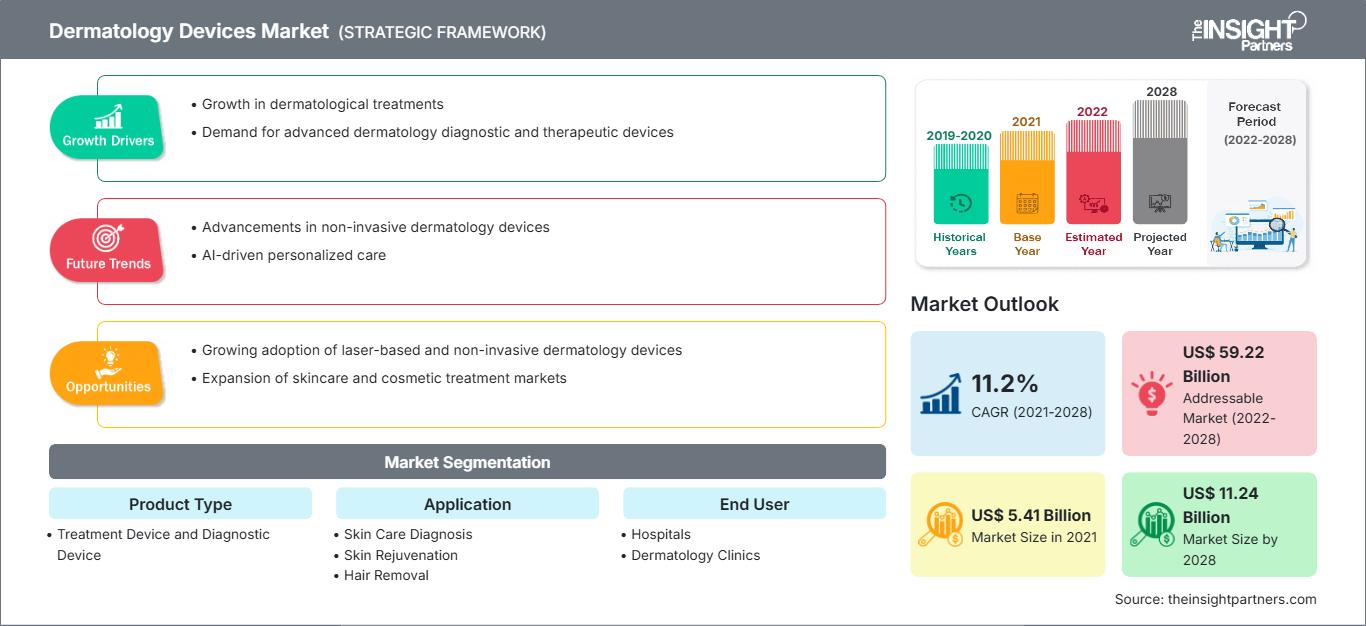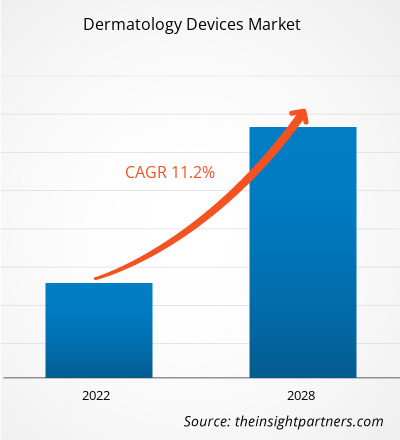2021年,全球皮肤病学设备市场价值54.0857亿美元;预计2022年至2028年的复合年增长率将达到11.2%。
本报告重点介绍了皮肤病学设备市场的流行趋势及其增长驱动因素。皮肤病学涉及使用各种医疗器械进行美容和医学皮肤病学手术。皮肤病学设备有助于诊断和治疗各种皮肤病,例如皮肤癌和牛皮癣。它们还可用于冷冻手术、光动力疗法、莫氏显微手术以及电干燥和刮除术。美国食品药品监督管理局 (FDA) 在这些设备的监管、批准和上市后监督中发挥着关键作用,确保了它们的安全性和有效性。
该报告对全球皮肤病学设备市场提供了深刻的见解和深入的分析,强调了各种参数,包括市场趋势、技术进步、市场动态和主要市场参与者的竞争格局分析。它还包括 COVID-19 大流行对所有地区市场的影响。COVID-19 对全球皮肤病学设备市场的影响总体上好坏参半。在这场全球健康危机中,医疗系统不堪重负,向所有患者提供医疗服务成为许多地区面临的关键挑战。此外,随着 COVID-19 大流行的进展,医疗器械公司发现管理运营面临困难。许多在美国开展业务的皮肤病学设备制造商都受到了疾病广泛爆发的不利影响。然而,随着病例数量的减少,疫情限制措施放松,皮肤科医生进行的美容手术数量也恢复了正常水平,医院也开始恢复选择性手术,从而推动了对皮肤科设备的需求。
自定义此报告以满足您的要求
您将免费获得任何报告的定制,包括本报告的部分内容,或国家级分析、Excel 数据包,以及为初创企业和大学提供超值优惠和折扣
皮肤病学设备市场: 战略洞察

- 获取本报告的主要市场趋势。这个免费样本将包括数据分析,从市场趋势到估计和预测。
您将免费获得任何报告的定制,包括本报告的部分内容,或国家级分析、Excel 数据包,以及为初创企业和大学提供超值优惠和折扣
皮肤病学设备市场: 战略洞察

- 获取本报告的主要市场趋势。这个免费样本将包括数据分析,从市场趋势到估计和预测。
皮肤病学设备市场 - 基于地理的洞察
按地理区域划分,全球皮肤病学设备市场分为北美(美国、加拿大和墨西哥)、欧洲(德国、英国、法国、意大利、西班牙和欧洲其他地区)、亚太地区(中国、日本、印度、韩国、澳大利亚和亚太地区其他地区)、南美洲和中美洲(巴西、阿根廷和南美洲和中美洲其他地区)以及中东和非洲(沙特阿拉伯、南非、阿联酋和中东和非洲其他地区)。
市场洞察
皮肤癌和皮肤病患病率不断上升
根据美国皮肤病学会 (AAD) 的报告,皮肤癌是美国最常见的癌症类型。据估计,美国每天有超过 9,500 人被诊断出患有皮肤癌。大多数皮肤癌病例属于非黑色素瘤皮肤癌 (NMSC),每年影响超过 300 万美国人。其中,女性 NMSC 的发病率最高,且年轻人群发病率不断上升。美国每年治疗皮肤癌的费用估计为 18 亿美元,其中 NMSC 为 48 亿美元,黑色素瘤为 33 亿美元。此外,Frontiers SA 的报告指出,皮肤癌的流行呈全球趋势。皮肤活检和组织病理学评估对于确诊皮肤癌至关重要。例如,用于记录和分析的成像技术、方法和设备的发展日新月异。皮肤镜成像设备将光照射到真皮上层,以观察和记录详细的色素变化。此外,无需活检即可检测细胞水平皮肤病变的高分辨率非侵入性诊断设备(例如共聚焦显微镜和多光子显微镜)也已得到市场的广泛认可。这些创新发展有效地帮助了皮肤癌的诊断、可疑病变变化的准确读取以及后续皮肤癌手术的有效性。
皮肤病是全球青少年和成年人面临的一个主要问题。痤疮、牛皮癣和酒渣鼻是人群中最常见的皮肤病。据美国皮肤病协会 (AAD) 估计,痤疮是最常见的皮肤病,每年影响多达 5000 万美国人。此外,美国约有 750 万人患有牛皮癣,主要见于成年人,其中 45 至 64 岁之间的患者比例最高。此外,根据 AAD 发布的报告,酒渣鼻是一种常见的皮肤病,每年影响 1600 万美国人。使用人工智能 (AI) 可以有效地诊断此类皮肤病。这些因素将为2022年至2028年期间全球皮肤病学设备市场带来丰厚的利润。
皮肤病学设备市场 - 基于产品的洞察
根据产品类型,全球皮肤病学设备市场分为治疗设备和诊断设备。治疗设备领域在2021年占据了更大的市场份额。
皮肤病学设备市场 - 基于应用的洞察
根据应用,全球皮肤病学设备市场分为皮肤癌诊断、皮肤再生、脱毛、塑身和紧致皮肤、牛皮癣等。皮肤癌诊断领域在2021年占据了最大的市场份额。
皮肤病学设备市场区域洞察
The Insight Partners 的分析师已详尽阐述了预测期内影响皮肤病学设备市场的区域趋势和因素。本节还讨论了北美、欧洲、亚太地区、中东和非洲以及南美和中美洲的皮肤病学设备市场细分和地域分布。
皮肤病学设备市场报告范围
| 报告属性 | 细节 |
|---|---|
| 市场规模 2021 | US$ 5.41 Billion |
| 市场规模 2028 | US$ 11.24 Billion |
| 全球复合年增长率 (2021 - 2028) | 11.2% |
| 历史数据 | 2019-2020 |
| 预测期 | 2022-2028 |
| 涵盖的领域 |
By 产品类型
|
| 覆盖地区和国家 | 北美
|
| 市场领导者和主要公司简介 |
|
皮肤病学设备市场参与者密度:了解其对业务动态的影响
皮肤科设备市场正在快速增长,这得益于终端用户需求的不断增长,而这些需求的驱动因素包括消费者偏好的演变、技术进步以及对产品优势的认知度的提升。随着需求的增长,企业正在扩展产品线,不断创新以满足消费者需求,并抓住新兴趋势,从而进一步推动市场增长。

- 获取 皮肤病学设备市场 主要参与者概述
皮肤科设备市场 - 基于终端用户的洞察
根据终端用户,全球皮肤科设备市场细分为医院、皮肤科诊所和其他。医院在2021年占据了最大的市场份额。然而,预计皮肤科诊所在2022年至2028年期间的复合年增长率将达到最高。
Alma Lasers(Sisram Medical)、Cutera Inc.、Candela Corporation、Solta Medical(Bausch Health Companies Inc.)、FotoFinder Systems's、Cynosure、Lumenis、El.En SpA、Leica Microsystem、Aerolase Corp. 是全球皮肤科设备市场的主要参与者。市场参与者一直在采用包括产品发布和扩张在内的有机战略,以扩大其全球业务范围和产品组合。
- 历史分析(2 年)、基准年、预测(7 年)及复合年增长率
- PEST和SWOT分析
- 市场规模、价值/数量 - 全球、区域、国家
- 行业和竞争格局
- Excel 数据集
近期报告
客户评价
购买理由
- 明智的决策
- 了解市场动态
- 竞争分析
- 客户洞察
- 市场预测
- 风险规避
- 战略规划
- 投资论证
- 识别新兴市场
- 优化营销策略
- 提升运营效率
- 顺应监管趋势




















 获取免费样品 - 皮肤病学设备市场
获取免费样品 - 皮肤病学设备市场